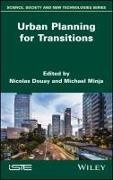Ulteriori informazioni
Today, as cities undergo rapid and dynamic transformations, riddled with uncertainties about the future, the roles of urban planning and urban planners lie in one of these new crossroad moments. Climate change, urban migration, social inclusion, health emergencies and financial and economic crises have elevated urbanization to newer heights of complexity that can only be tackled by integrating a multitude of scenarios, strategies and discourses, in order to create an urban future that is resilient and sustainable.
Urban planners have come up with transition proposals and concepts that they hope will be able to respond to cities? challenges and ultimately allow them to adapt and make the transition into more robust urban areas. This book presents and discusses various urban transition strategies, action plans and programs that have been proposed or even conducted in different countries all over the world. Different countries require different strategies, but they all have the same goal in mind, each of them trying to address urban complexities and cope with the rapid pace at which the world is evolving.
Sommario
Introduction xi
Nicolas DOUAY and Michael MINJA
Chapter 1. Rotterdam Resilience Strategy, Rotterdam 1
Munir KHADER
1.1. Introduction 1
1.2. Context and background 1
1.3. Rotterdam Resilience Strategy - Ready for the 21st Century 3
1.3.1. Methodology 3
1.3.2. Rotterdam Resilience Strategy - Goals, stakeholders 5
1.3.3. Concrete resilient initiatives and programs 7
1.4. Conclusion 16
1.4. References 17
Chapter 2. Sustainable Florianópolis Action Plan, Santa Catarina 19
Flavia HOLLERWEGER
2.1. Introduction 19
2.2. Context: Florianopolis' background 20
2.3. The Sustainable Florianópolis Plan of Action 22
2.3.1. A comprehensive analysis of the city 22
2.3.2. Methodology 23
2.3.3. Goals and actions 24
2.4. Analysis - Discussion 29
2.5. Conclusion 31
2.6. References 32
Chapter 3. "Recife 500 Anos" Plan, Recife 33
Maria Carolina ARRUDA
3.1. Introduction 33
3.2. Strategy, transition and innovation in a contrasting urban scenario 33
3.2.1. Recife: Brazil's "capital of inequalities" 34
3.2.2. From an economic-oriented urbanism to a participatory strategic plan 36
3.3. The plan 37
3.3.1. A multi-institutional board 38
3.3.2. Research, public consultation and comparative analysis 39
3.3.3. Crossing strategies for integrated results 40
3.4. Critical analysis of the plan construction 43
3.5. Conclusion 45
3.6. References 46
Chapter 4. Greenest City 2020, Vancouver 47
Hala RAHOUI
4.1. Introduction 47
4.2. Context 48
4.3. Greenest City 2020 Action Plan - targets and goals 52
4.3.1. GCAP goals 53
4.3.2. Implementation updates 63
4.4. Why is the GCAP an innovative urban strategy? 65
4.5. Criticisms 65
4.6. Conclusion 66
4.7. References 66
Chapter 5. The Grandeur Nature Plan, Eurométropole of Strasbourg 69
Luc VOELKEL
5.1. Introduction 69
5.2. The Grandeur nature plan of the Eurométropole of Strasbourg 70
5.2.1. The stakeholders involved in the implementation of the plan 70
5.3. The content of the plan 73
5.4. The role of the Grandeur nature program 80
5.5. Conclusion 83
5.6. References 84
Chapter 6. The Car-free Livability Programme, Oslo 87
Michael MINJA
6.1. Introduction 87
6.2. Background: the Car-free Livability Programme of Oslo 88
6.3. The role of the Car-free Livability Programme and specific developments brought by it 91
6.3.1. Advocating city life at the expense of parking space 91
6.3.2. Exploratory urban development projects 92
6.3.3. New pedestrian streets and pedestrian-friendly urban spaces 93
6.3.4. The city center planning model for the future streets 95
6.4. Car-free city centers are not utopian models anymore 96
6.5. Conclusion 99
6.6. References 100
Chapter 7. A Carbon-free City, Uppsala 103
Bérénice JOURNET
7.1. Introduction 103
7.2. Context 104
7.3. The environmental program of Uppsala's municipality 107
7.3.1. Ambitions 107
7.3.2. Mobility 108
7.3.3. Green spaces as social areas 112
7.3.4. Fossil fuel free 114
7.4. An ambitious and inclusive environmental program: between ambitions and social realities 116
7.5. Conclusion 118
7.6. References 119
Chapter 8. The Bicycle Strategy 2011-
Info autore
Nicolas Douay is Professor of Urban Planning at University of Grenoble Alpes, France, where he teaches at the Institute of Urban Planning and Alpine Geography and conducts research at Pacte, a social science research center.
Michael Minja is an architect from Tanzania and a recent Urban Planning Master¿s degree graduate from the University of Grenoble Alpes, France. He has worked as a freelance architect and has also taken part in various urban planning workshops, symposiums and research.

